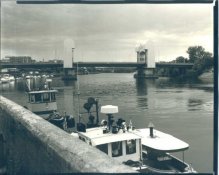Interesting thread.
Someone just gave me a 25 sheet pack of Kodak 4125 - I was wondering if it could be used as...I think I just figured out what the 'in camera film' statement meant..I don't have any need to copy like it was originally intended for, but want to use it as 'ortho' film in film holders in a camera.
Does anyone have any idea what ISO to use outdoors with 4125? Let's ignore the out-of-date factor - I can deal with that later if necesssary - I just want to get in the ballpark.
I also got a box of 8x10 'high definition x-ray imaging film', which is apparently a single emulsion, ortho film. I don't know if it's true 8x10 or fits our kind of filmholders - I tossed it in the refrigerator as soon as it arrived.
It's private labeled. I found out who made it and have been bugging both companies for misuse and abuse info...they don't seem to know how to answer spectral and resolution questions. What constitutes 'high definition' in x-ray work doesn't seem to mean anything to anyone I've asked yet...other than the suggestion that single emulsion has higher definition than double emulsion.
BTW, someone told me household bleach can be used to remove emulsion from one side, but I think that exceeds even MY limits for impracticality.
I hope this next question fits with this thread...I'm thinking if I can find my Minor White et al Zone System book, there was a discussion of controlled exposure testing - but lacking it in-hand at the moment, I'll ask.
Is there a better 'plan' to figure out how to misuse mystery film, outdated film etc., than to just meter an 18% gray card and open a dark slide a fraction of a sheet at a time for increasingly longer exposures, say 1/8 sheet @ t seconds, 1/4 sheet at 2 x t seconds, 3/8 sheet at 3 x t seconds and so on?
Someone suggested to me defocussing the lens after 'composing' on the gray card to avoid distraction by the texture...I didn't understand the benefit of that.
Thanks
Murray











